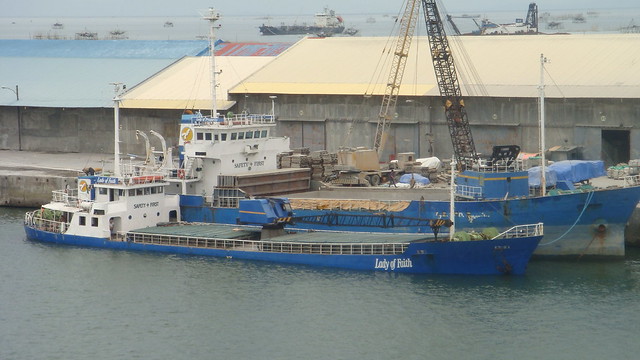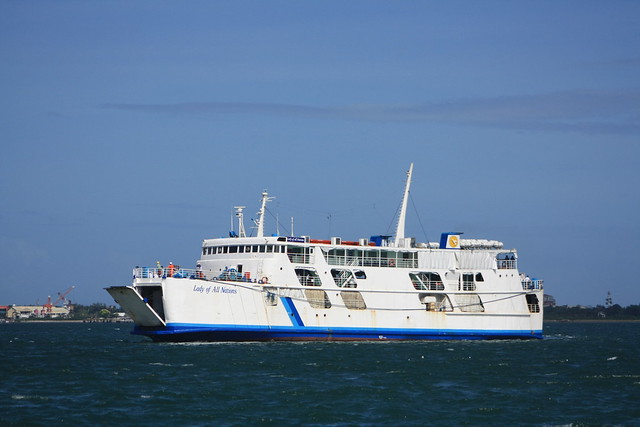
Medallion Transport 2014 Calendar © John Carlos Cabanillas
Like many other shipping companies, Medallion Transport had simple beginnings. They had a relatively recent start as in about 1998. Their first route was bridging the Canigao Channel using the ports of Bato, Leyte and Ubay, Bohol. Their start was propitious for this was the time intermodal travel using short-distance ferry-ROROs was beginning to take off. In Cebu, I had many queries regarding their offices or sites. They assumed Medallion Transport is a Cebu shipping company. But, in fact, Medallion is a Leyte shipping company and that gives me pleasure to point that out since not many shipping companies not in shipping centers made it successfully.
Medallion Transport did not really reinvent a lot of things and I am not saying this in a negative way. They are relatives of the owners of Roble Shipping who seem to have been supportive of and friendly to them. Not my type to really highlight personalities (I would rather highlight the moves and the circumstances) but I found it funny that when they had their first hull loss, the sinking of the MV Lady of Carmel, few in media got the last name of the owner and founder correct which is Fulache (another instance when reporters should realize they have to have the names spelled out to them or they should go to an otologist).
Medallion Transport started with basic, short-distance ferries. Among these are the MV Lady of Guadalupe-Cebu, the MV Lady of Hope, the MV Lady of Charity and the MV Lady of Carmel. All are ROROs except for the second one which was the former MV Talibon Cruiser. The MV Lady of Hope they did not source from Japan but from a defunct Bohol shipping company. For nearly a decade, they relied on these four vessels. Two of them are gone now. The MV Lady of Hope was broken up and the MV Lady of Carmel sank off Burias Island in Masbate province.

M/V Lady of Charity © Jun Yu Marquez
From the Bato-Ubay route, Medallion Transport sailed the Bato-Cebu route and they simply shoehorned then their basic, short-distance ferry-ROROs into an overnight route. The advantage they had over their competition South Pacific Transport (which had the cruiser ships MV Fiji-II and MV South Pacific) was they had ROROs (well, vehicles generate much more revenues compared to passengers and if these are traders’ trucks then these will probably return to its origin and do repeated journeys).
I thought then that Medallion Transport would follow the experience of Roble Shipping on giving a higher priority on ferries at the start. I was mistaken. What I noticed was their Phase 2 consisted of acquiring small freighters to be used as trampers. Some of these were dredgers when they were in Japan (and one would wonder why our government can’t purchase dredgers when many of their old ones are no longer running). These recent years, one staple cargo of these freighters is cement and I notice companies which can transport cement cheaply are doing well. Like Medallion. Along the way, Medallion Transport established the twin legal fiction company, the MC Phil Maru Shipping Company. Some of their freighters are registered under that company.
For nearly a decade, Medallion Transport did not acquire ferries. What they acquired were the freighters MV Lady of Prosperity, MV Lady of Peace, MV Lady of Faith, MV Lady of Courage, MV Lady of Rosary, MV Lady of Remedy, MV Lady of Wisdom, MV Lady of Divine Grace and the MV Lady of Good Success. With such fleet, I sometimes looked then at Medallion Transport as more of a cargo shipping company. But looking back this was the right move then because at the start of the new millennium there was still a surplus of bottoms in the Camotes Sea routes (and a lot of companies would fail there in the first decade of the new millennium).

Medallion Transport freighters M/V Lady of Faith and M/V Lady of Prosperity © ZoSeL_BaDz (Flickr)
Then came Phase 3 of the expansion of the company which was intertwined with the later freighter acquisitions. From 2007 came a series of ferries starting from small into bigger ones. The MV Yellow Rose was acquired from the troubled Rose Shipping Lines (but they later gave up this ferry). Then the MV Ayako was acquired from the troubled R&D Philippine Company and she was refitted into the MV Lady of Angels. After her came two small ferry-ROROs, the MV Lady of Miraculous Medal (which was the first MV Lite Ferry 10 of Lite Ferries) and the very small MV Lady of Sacred Heart. By this time, Medallion Transport was able to penetrate the Bicol waters and ply the Masbate City-Pio Duran, Albay short-distance ferry route where they initially used the MV Lady of Carmel and the MV Lady of Miraculous Medal. Maybe to endear themselves to the locals (as their competitor in the route is a true Bicolano), they also named the MV Lady of Carmel as the “Barko Masbateno”.
Phase 3A of their expansion then came and this was the acquisition of true overnight ferries. I was astounded that they were able to purchase two overnight ferries from Moreta Shipping Lines of Manila that were barely sailing then as they had already lost to the intermodal buses and trucks. First to come was the MV Nikki, the first ship of Moreta Lines which was renamed into the MV Lady of All Nations. Then came the flagship of Moreta Lines, the MV Love-1 which was refitted into the MV Lady of Love. The latter ship, ship spotters said, was even fit to belong to Trans-Asia Shipping Lines. This was not a derogatory opinion and there is no implication whatsoever that Medallion Transport is unworthy of her. It is more in admiration as she is the first proof that Medallion Transport has already “arrived”. By this time, the company already had the Cebu-Palompon route, a route whose potential was not realized by the other companies.

M/V Lady of Love © James Gabriel Verallo
Then the MV Lady of Good Voyage came. Originally, she was used in the Masbate-Pio Duran route. Then she was refitted, scantlings were added and she was converted into an overnight ferry-RORO. She was then fielded in the Cebu-Dipolog route, a route Medallion Transport pioneered. This route is potentially a blockbuster in the future, at least on the passenger side since it is a direct ship to the center of that part of Mindanao and a key connection point to other towns of Zamboanga del Norte and Zamboanga Sibugay and to as far as Zamboanga City.
Now the assignment of the overnight ferry-ROROs of Medallion Transport are: for Palompon, the MV Lady of Love, for Dipolog, the MV Lady of Good Voyage and for Bato, the MV Lady of All Nations. They also still sail the smaller MV Lady of Miraculous Medal and MV Lady of Angels to their Leyte routes.

M/V Lady of All Nations © Vincent Paul Sanchez
At the same time these overnight ferries came, Medallion Transport also built their new building in the ticket booth row outside Pier 3 of Cebu. Aside from being the newest, it is the best and most handsome in that row. When I saw that building, I said to myself, “That is the statement of Medallion Transport to the Cebu shipping scene that “they have already finally arrived”.
